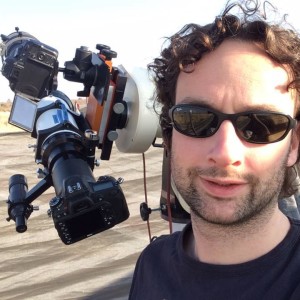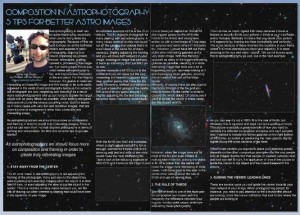
I started with astrophotography in June 2012, basically when I ‘discovered’ the amazing results amateur astrophotographers can achieve nowadays with relatively simple (!) equipment and a normal DSLR. I had been interested in cosmology for years already and was active with (wildlife) photography as a hobby as well. I started to combine these interest areas by photographing the night sky, DSO’s in particular. Having this background in ‘regular’ daytime photography I focus a lot on the aesthetics of the resulting images in general and pay particular attention to composition and to ‘soft’ processing with attention to colour preservation in stars.
“I’d rather spent my money on trips to great dark skies than buying more expensive equipment that I can only use under light polluted skies.”
I live in the Netherlands, so light pollution and the weather is always a struggle. I have a spot I go to some 30 minutes drive away from my home, which is relatively dark at zenit (at least the Milky Way is visible there) but still not very good.
Twice a year I go on an astrotrip to darker skies (SQM 21) with some friends to either Hohen Woos (Germany) or Lalobbe (France), both around 4 to 5 hours drive from home.
Next to this I also went to La Palma last year and was lucky to have 9 clear nights there. This year I decided to go to Namibia, to astrofarm Kiripotib. Trips like these give me access to truly amazing skies and in my opinion nothing can beat real dark skies; I’d rather spent my money on trips to skies like this than buying more expensive equipment that I can only use under light polluted skies.
I started out using my Nikon D7000 for astrophotography mainly because I already owned this camera. Now, 3 years later, I still stick to using DSLRs for astrophotography. This is mainly due to the excellent value for money you get with DSLRs and the great results you can achieve under good dark skies, even with unmodified camera’s!
Clear Skies!
Contact me: c.vdberge (at) gmail (dot) com
Acknowledgements and publications
APOD
NASA Astronomy Picture Of the Day
Astrobin
Picture of the day
- August 12, 2015 – Pipe Nebula with Lagoon and Trifid
- August 09, 2015 – Centaurus A
- August 08, 2015 – Wide field view on Sagittarius with M20, M8, M16, M17 and M24
- Issue 19, August 2015 – 5 tips for better astrophotography
BBC’s Sky at Night
- October issue, 2015 – Hotshots Gallery: A Sagittarius Triplet
- November issue, 2015 – Hotshots Gallery: Pipe Nebula
Sky & Telescope
Equipment:
Mounts and tripods
- NEQ6
- Astrotrac
- Manfrotto tripod
- Manfrotto 468MGRC4 ball head
- Redged RNB-1n ball head
Telescopes and photo lenses for astrophotography
- Newton 1000mm F5
- TS Quadruplet 480/80
- Orion 50mm Guidescope
- Samyang 14mm F2.8
- Nikkor 80-200mm F2.8
- Nikkor 24-85mm F2.8-F4 AF-D
- Nikkor 50mm F1.8 AF-D
- Sigma 10-20mm F4-F5.6
Cameras; DSLR and guiding
- Nikon D600 Modified
- Nikon D600 Monochrome
- Nikon D7000
- Nikon D5100 Modified
- Lacerta MGEN
Astrophotography Software (on Mac)
- PixInsight
- Stellarium
- qDslrDashboard
- RedScreen
Mobile Apps
PhotoPills
SkySafari+
Clear Outside
Aurora Fcst
WeatherMap+


Mooie site Christian en vooral de interviews heb ik met veel plezier gelezen en vind ik een nuitstekend initiatief.
Ga zo door, groeten Tim
[…] A Sagittarius Triplet – Crédito da Imagem ©: Christian vd Berge (DSLR […]
Great website and great info. I am thinking of picking up a Nikon D7100 so your use of the 7000 and other Nikon equipment are really relevant for me.
Thanks again!
Somewhere I saw an ad for a pair of focus rings that allowed careful focusing of a telephoto lens, then locking it in place. Any idea where I can find it?
Do you mean something like this?
http://www.teleskop-express.de/shop/product_info.php/language/en/info/p3286_Microfocuser-and-focus-lock-fuer-camera-lenses-up-to-D-135mm.html
that was it.Thanks. New question: Balancing longer imaging time (thus need for more accurate tracking/alignment) vs ISO.Is 4 min at 200 really better than 1 min at 800?
Depends on the sky you are under and the read noise of your camera at those ISO values.
In general; under dark skies the 4min will always be better, since you are read noise limited and you get the same amount of read noise per 4min as per 1 min (relatively)
Therefor I don’t like the habit of tying ISO to exposure time, as ISO really is just an amplification and does nothing to SNR in itself, other than providing a certain amount of read noise. So normally you should have the comparison; ISO200 vs ISO800 at 4 min.
Now, since you ask this question while tying the ISO to the exposure, I suspect you are under light polluted skies where you can’t expose at ISO 800 for 4 minutes for instance. If this is the case; don’t worry about your subexposure length. It doesn’t matter. Pick the ISO that provides good DR and exposure lengths that work for you in terms of guiding, weather etc.
[…] Christian van den Berge | Click image to enlarge or here for full size […]
Well done Chris. Just found this site. Lots of good info!
Really informative site!
I learned a lot about PI, cameras and much more from it.
I’m also very glad with your camera brand comparisons. Very nice to see what things really matter!
Keep up the posting!
Groeten, Klaas Pieter
Just came across your site and found it brilliant, very refreshing to have such sharp info and articles about DSLR astro photography rather that CCD focused cameras.
Great work, Thanks
Hi Chris
I am a photographic guide, and when you came to south africa more specific cape town, Ill take you to a place in the cederberge with bortle 1-2 skys or great Karoo close to Sutherland free of charge ((-:
Hi Guido,
Guess I’ll have to make a trip to south africa then 😉
cheers
Mám dotaz jaký je max,espoziční čas v minut. pro Canon 450Da.Děkuji.